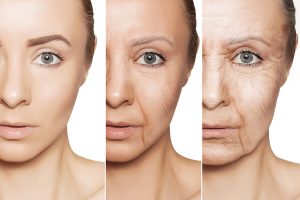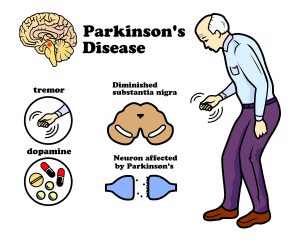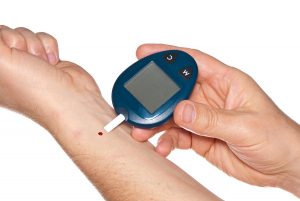A review article has examined longevity and reviewed the downside of living to 100. In their 80’s about 10% of the population live in nursing homes, but among centenarians 55% are residing in nursing homes. They are often very lonely, as their social circles have shrunk as they aged.
Common diseases of older people
Osteoarthritis makes it difficult for people to get around, it causes chronic pain and it can also be the reason for falls. In 1990 there were 213.4 cases of osteoarthritis per 100,000. 26 years later, in 2016 there were 232.1 cases of osteoarthritis per 100,000 people.
Chronic obstructive pulmonary disease (COPD) has been falling, because less people smoke cigarettes now. Statistics show 1667 cases of COPD per 100,000 in 1990, but only 945 cases of COPD per 100,000 in 2016.
Diarrhea and common infections have dropped sharply from 8951 per 100,000 in 1990 to 3276 per 100,000 in 2016.
What other common diseases do older people get?
There are a number of common diseases that affect the elderly.
Osteoarthritis
Osteoarthritis of the hips and the knees are common, but it can affect every joint in the body. In the end stage knee replacements or hip replacements may be necessary. But before a total knee replacement or total hip replacement can even come into consideration, the person’s heart needs a thorough checkup to ensure that it is safe for the patient to undergo surgery under a general anesthetic.
Heart disease
Older people often have heart disease.
When coronary arteries are narrowed, heart attacks occur. Cardiologists can place stents, so that previously narrowed coronary arteries receive normal blood flow. Following such a procedure the patient may live for another 10 to 15 years.
There are also heart valve calcifications. The aortic valve is particularly endangered. A heart surgeon may be able to replace a diseased aortic valve by a porcine valve.
The nervous system of the heart transmits electrical signals from the sinus node to the muscle fibers, which can get diseased. Heart rhythm problems may necessitate the insertion of a pacemaker.
Finally, the heart may enlarge, but pump less blood than before. This condition is congestive heart failure. The 5-year survival for this condition is only 50.4%. Unfortunately there is very little the doctor can do for patients like this.
Cancer
The older we get, the more DNA mutations we accumulate. At one point cancer develops. If the diagnosis happens at an early stage there is a good chance that surgery can remove a cancerous growth, and the patient survives. But there are cancers that are notoriously difficult to recognize in the early stages. These are: cancer of the pancreas, kidney cancer, stomach cancer and certain types of leukemias.
Respiratory diseases
Those who smoked earlier in life may develop chronic obstructive pulmonary disease (COPD). It is a chronically disabling lung disorder. Often these individuals have to carry an oxygen tank with them wherever they go. The 5-year survival rate for people with COPD is 40 to 70%.
Osteoporosis
Osteoporosis is a disease where the bone is brittle. Spontaneous bone fractures can occur at the wrists, the upper thigh bone (femoral fractures) or in the vertebral bones. Women in menopause are hormone deficient and this contributes to calcium depletion of the bones. Lately research has shown that vitamin K2 and vitamin D3 are necessary for a normal calcium metabolism. Briefly, 200 micrograms of vitamin K2 and 5000 IU of vitamin D3 every day are the necessary dosage that the body can absorb calcium from the gut, eliminate it from the blood vessels and deposit it into the bone. Calcium is present in milk products and milk. If a person does not consume enough milk products a supplement of 1000 mg of calcium daily does make sense.
Alzheimer’s
The older we get, the more likely it is an onset of Alzheimer’s or dementia. Between the ages of 90 to 94 there is a yearly increase of Alzheimer’s of 12.7% per year. The group from age 95 to 99 years has a yearly increase of Alzheimer’s of 21.2% per year. Persons aged 100 years and older have an increase of Alzheimer’s by 40.7% per year. What this means is that essentially there is a doubling of Alzheimer’s every 5.5 years. We do not have all of the answers why this is happening and why Alzheimer’s develops. But we do know that diabetics are more likely to develop Alzheimer’s. High blood sugar levels and high insulin levels seem to lead to the precipitation of the tau protein in the brain, which causes Alzheimer’s.
Diabetes
When diabetes is not well controlled, there is accelerated hardening of the arteries. This can cause heart attacks and strokes. Longstanding diabetes can affect the kidneys (diabetic nephropathy, kidney damage) and can lead to hardening of the leg arteries. Often the only treatment left is a below knee amputation. Blindness from uncontrolled diabetes is common and pain from diabetic neuropathy as well.
Diabetics have an average life expectancy of 77 to 81 years. However, if they pay attention to their blood sugars and manage their diabetes closely they can live past the age of 85.
Falls and balance problems
As people age, their balance organ is not functioning as well. Also, people with high blood pressure medication may have postural hypotensive episodes that can lead to falls.
There may be a lack of cognitive functioning and misjudging of steps, ledges and irregularities in the floor. When a person has brittle bones from osteoporosis and they fall, a hip fracture is very common. At a higher age surgery for a hip fracture is dangerous. It can have a mortality of 50%.
Obesity
A person with obesity has a life expectancy that is 10 years less than a person without obesity. The reason for this is that with obesity This is so, because the risk of heart attacks, strokes, cancer, arthritis and diabetes is increased.
Depression
Older people often get depressed. It even has its own name: involutional depression. People can get into a state of mind, where they think negatively. Depressed people feel that they have nothing to live for. They lost friends; they are shut in because they can’t drive a car any more. This type of depression needs treatment by a psychologist or psychiatrist. The danger of leaving depression untreated is that the person may get suicidal. In older people depression is often precipitated by physical health problems.
Oral health
When teeth are not looked after, gingivitis and periodontitis can develop. Infected gums can shed bacteria into the blood and this can affect the heart valves. Endocarditis, the infection of heart valves, is a cardiological emergency. Prolonged antibiotic therapy is necessary to overcome this condition.
Poverty
Poverty has real consequences. The aging person may not have access to the optimal medical care facility because of a lack of funds. But even at a younger age there is evidence that people are healthier when they are wealthier.
Shingles
Older people often get shingles, even if they had chickenpox or shingles as a child. This is evidence that the immune system is getting weaker. Shingles in an older person should alarm the treating physician that there could be an underlying cancer. Due to that knowledge a cancer-screening tests should be part of the medical exam. In addition, a varicella vaccine should be offered to the patient to build up immunity.
Conclusion
Living to 100 is often glorified in the press. Maybe you have seen a 90-year old jogger completing a marathon, or you saw an 85-year old couple ballroom dancing. But what they don’t show you is what I summarized here, the less glamorous things about living to 100. You may get a heart attack or a stroke. Osteoarthritis may affect you how you walk. Congestive heart failure may make you get short of breath when you walk upstairs. Then there are various cancer types that are difficult to diagnose early.
If you have smoked in the past, you may suffer from chronic obstructive pulmonary disease (COPD), which leaves you breathless.
Other illnesses
Osteoporosis can lead to spontaneous fractures. Because the bone has a lack of calcium, this is difficult to treat and takes a long time to heal.
Alzheimer’s is ever so much more common when you approach the year 100. There are other medical conditions you can get: obesity, diabetes and depression. When you get shingles for the second time, it may mean that your immune system is getting weak and a cancer-screening test should be done.
There are some downsides when you approach the age of 100.
Know your risks and be vigilant
You may keep your physician busy checking out various age-related illnesses, but more importantly, get regular check-ups and tests. Any condition is easier to treat with an earlier diagnosis! The message for anybody reading this is very simple. Prevention through healthy living is something you can actively pursue. Keep your body and your mind busy. Enjoy time with friends and family instead of living a solitary existence. See the glass that is half full instead of viewing it as half empty. Stick to a healthy diet. Knowing all the risks is not a scare but a call to being vigilant. Knowledge is powerful and will help you to enjoy your golden years feeling well and happy.















